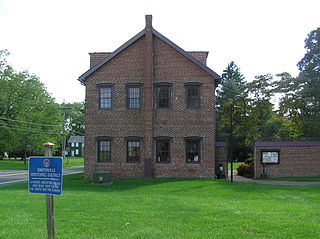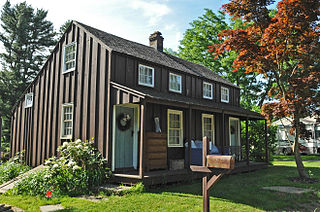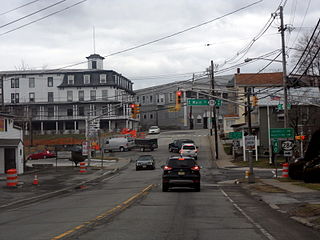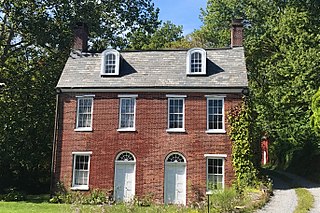
Eastampton Township is a township in Burlington County, in the U.S. state of New Jersey. As of the 2020 United States census, the township's population was 6,191, an increase of 122 (+2.0%) from the 2010 census count of 6,069, which in turn reflected a decline of 133 (−2.1%) from the 6,202 counted in the 2000 census. The township, and all of Burlington County, is a part of the Philadelphia-Reading-Camden combined statistical area and the Delaware Valley.

Mine Hill Township is a township in Morris County, in the U.S. state of New Jersey. It is a residential community located just west of the center of Morris County, and northwest of the county seat Morristown.

Mount Olive Township is a township in Morris County, in the U.S. state of New Jersey. As of the 2020 United States census, the township's population was 28,886, its highest decennial census count ever and an increase of 769 (+2.7%) from the 2010 census count of 28,117, which in turn reflected an increase of 3,924 (+16.2%) from the 24,193 counted in the 2000 census. Located within the Raritan Valley region, Mount Olive is situated in western Morris County bordering both Sussex and Warren counties along the Musconetcong River.

Sussex is a borough in Sussex County, in the U.S. state of New Jersey. As of the 2020 United States census, the borough's population was 2,024, a decrease of 106 (−5.0%) from the 2010 census count of 2,130, which in turn reflected a decline of 15 (−0.7%) from the 2,145 counted in the 2000 census.

Vernon Township is a township in Sussex County, in the U.S. state of New Jersey. It is located about a one hour drive from New York City and is part of the New York Metropolitan Area. As of the 2020 United States census, the township's population was 22,358, a decrease of 1,585 (−6.6%) from the 2010 census count of 23,943, which in turn reflected a decline of 743 (−3.0%) from the 24,686 counted in the 2000 census. It is both the most populous municipality and the largest in area in the county.

Pohatcong Township is a township in Warren County, in the U.S. state of New Jersey. As of the 2020 United States census, the township's population was 3,241, a decrease of 98 (−2.9%) from the 2010 census count of 3,339, which in turn reflected a decline of 77 (−2.3%) from the 3,416 counted in the 2000 census.
A borough, in the context of local government in the U.S. state of New Jersey, refers to one of five types and one of eleven forms of municipal government.
A township, in the context of New Jersey local government, refers to one of five types and one of eleven forms of municipal government. As a political entity, a township in New Jersey is a full-fledged municipality, on par with any town, city, borough, or village. They collect property taxes and provide services such as maintaining roads, garbage collection, water, sewer, schools, police and fire protection. The Township form of local government is used by 27% of New Jersey municipalities; however, slightly over 50% of the state's population resides within them.
A village, in the context of New Jersey local government, is one of five types and one of eleven forms of municipal government.
A city in the context of local government in New Jersey refers to one of five types and one of eleven forms of municipal government. Despite the widely held perception of a city as a large, urban area, cities in New Jersey have a confused history as a form of government and vary in size from large, densely populated areas to much smaller hamlets.
A town in the context of New Jersey local government refers to one of five types and one of eleven forms of municipal government. While town is often used as a shorthand to refer to a township, the two are not the same.

The Mayor of the City of Jersey City is the head of the executive branch of the government of Jersey City, New Jersey, United States. The mayor has the duty to enforce the municipal charter and ordinances; prepare the annual budget; appoint deputy mayors, department heads, and aides; and approve or veto ordinances passed by the City Council. The mayor is popularly elected in a nonpartisan general election. The office is held for a four-year term without term limits, although the current term is a four-and-a-half-year term, due to a change in election dates.
A special charter allows a New Jersey municipality to operate under a charter that differs from those of the traditional forms of government or the many options available under the Faulkner Act. Under the terms of the New Jersey State Constitution of 1947 and the Faulkner Act of 1950, a municipality may obtain a special charter form from the New Jersey Legislature, providing a unique form of governmental organization for that community.
The state of Michigan is largely divided in the same way as many other U.S. states, but is distinct in its usage of charter townships. Michigan ranks 13th among the fifty states in terms of the number of local governmental entities.
Local government in New Jersey is composed of counties and municipalities. Local jurisdictions in New Jersey differ from those in some other states because every square foot of the state is part of exactly one municipality; each of the 564 municipalities is in exactly one county; and each of the 21 counties has more than one municipality. New Jersey has no independent cities, or consolidated city-counties.
Bayonne, New Jersey was incorporated on April 1, 1861 as a township. It was reincorporated on March 10, 1869 as a city. It is currently governed within the Faulkner Act, formally known as the Optional Municipal Charter Law, under the Mayor-Council system of municipal government, implemented based on the recommendations of a Charter Study Commission as of July 1, 1962, before which it was governed by a Board of Commissioners under the Walsh Act. The governing body consists of a mayor and a five-member city council, of which two seats are elected at-large and three from wards. This is a list of mayors of Bayonne, New Jersey.
Rumson, New Jersey, was incorporated on June 18, 1907. It is governed under the borough form of New Jersey municipal government. The governing body consists of a mayor and a borough council comprising six council members, with all positions elected at-large on a partisan basis as part of the November general election. A mayor is elected directly by the voters to a four-year term of office. The borough council consists of six members elected to serve three-year terms on a staggered basis, with two seats coming up for election each year in a three-year cycle. The borough form of government used by Rumson, the most common system used in the state, is a "weak mayor / strong council" government in which council members act as the legislative body with the mayor presiding at meetings and voting only in the event of a tie. The mayor can veto ordinances subject to an override by a two-thirds majority vote of the council. The mayor makes committee and liaison assignments for council members, and most appointments are made by the mayor with the advice and consent of the council.

Spotswood is a borough in Middlesex County, in the U.S. state of New Jersey. The community is nestled within the heart of the Raritan Valley region, with the Manalapan Brook and Matchaponix Brook forming the confluence of the South River inside the borough. As of the 2020 United States census, the borough's population was 8,163, a decrease of 94 (−1.1%) from the 2010 census count of 8,257, which in turn reflected an increase of 377 (+4.8%) from the 7,880 counted in the 2000 census.








